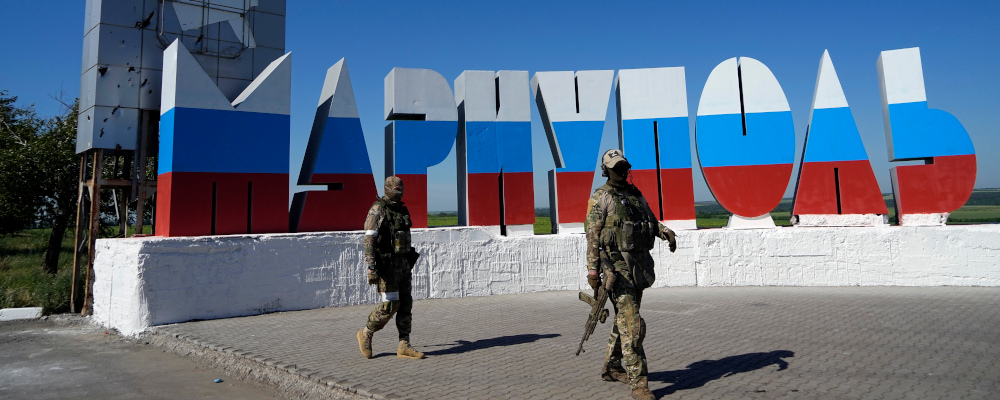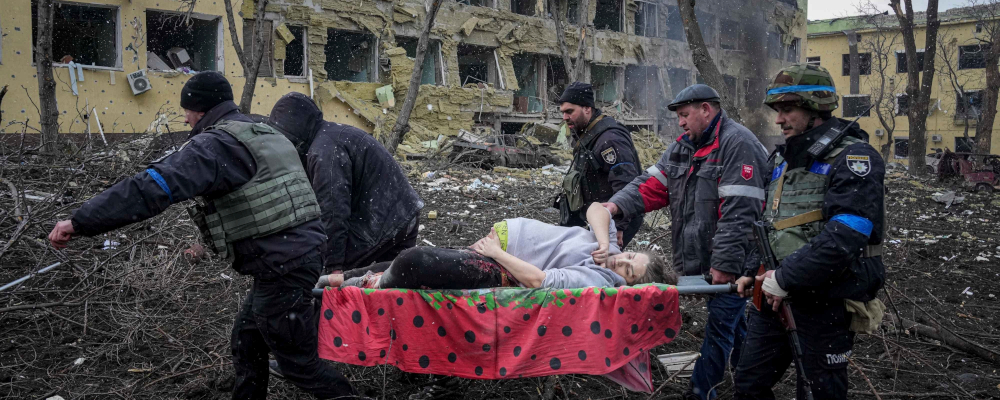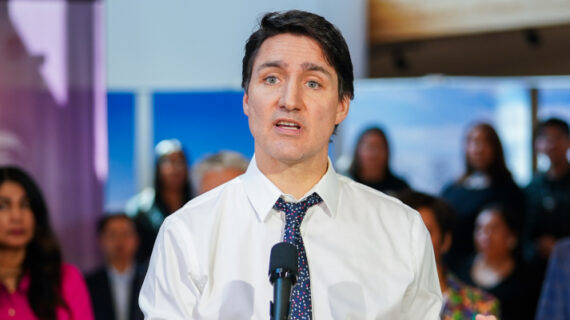Nearly eight decades since the defeat of Nazism, the West again faces the spectre of fascism in Europe. Two years after Russia’s full-scale invasion of Ukraine, Vladimir Putin’s regime—freshly victorious in the country’s latest sham election—is using the brutal destruction and rapid regeneration of the Ukrainian city of Mariupol as a showpiece for a new, fascist Russia.
In an era when accusing opponents of “fascism” is commonplace across the political divide in the West, we as authors do not deploy the term “fascism” lightly. To do so risks devaluing the term. Yet by considering what fascism really is, and exploring the fate of Mariupol, we can show that today’s Russia really does have fascist ambitions.
Russia’s Fascism
Fascist states view the existing world as decadent, corrupt, and diseased—a far cry from their romanticized utopian past, when the nation in question supposedly lived harmoniously, cleanly, and with unimpeded international power (hence Adolf Hitler’s obsession with medieval German knights and national power).
For fascists, the world must be transformed through violent, revolutionary action: the total destruction of the “disease” that has infected the nation. Fascist nations demand an enemy, for it is only through obliterating that enemy that they can rejuvenate themselves. Thus, in the fascist imagination, everyone from politicians to ordinary people is wrapped up in an existential battle to save the spirit of the nation. The end—saving civilization—justifies any means. And the evidence shows that ordinary Russians are buying into the state’s vision.

Of course, the promise of rejuvenation through destruction is absurd and illogical. It is doomed to failure, for it cannot resolve real social, political, or structural problems. One enemy must be viciously attacked and then another one immediately targeted. This most extreme of political systems, as the Italian philosopher Umberto Eco put it, therefore finds itself in a state of “permanent warfare.”
It is increasingly clear that Putin’s Russia is a fascist nation. Barely a year of the 24 years Russia has spent under Putin has gone by without war: against Chechnya, against Georgia, against Ukraine, against ethnic and sexual minorities at home, and—of course—against the West.
But Putin does not wage war for geopolitical reasons. He wages war because he hopes through conflict to regenerate his own nation. Putin, like the fascists Hitler and Benito Mussolini did 80 years ago, seeks to purify his own country through the destruction of Ukraine—a state that he views as both a false construction that has never and can never exist, and as a land of Russians deformed by exposure to Western decadence.
Mariupol as the centrepiece
Putin is ready to obliterate Ukraine and Ukrainians to “cleanse” Russia. Nowhere is that better exemplified than in the horrifying treatment meted out to Mariupol, which was once a bustling city and regional hub in southeastern Ukraine.
For two months during spring 2022, Mariupol’s civilians and buildings were subjected to a brutal military bombardment and campaign of terror. The city was all but destroyed. Estimates vary regarding the number of civilian casualties, but the death toll in Mariupol is nonetheless staggering, from nearly 10,000 to potentially many times that number. Many who survived were deported to Russia through filtration camps where they suffered torture and humiliation, and, in some cases, disappeared. They were forcibly separated from their children, tens of thousands of whom were sent to orphanages in Russia where they were put up for adoption by strangers.
Russian propagandists and politicians welcomed the destruction of Mariupol with glee, embracing the obliteration of both the city and its population. Russian state television egged on Mariupol’s destruction, describing Ukraine as “a cancerous growth that needs to be eliminated all the way to the border with Poland. We can’t allow even a small part of it to remain.” Vladimir Putin confirmed that destruction was a “natural and necessary self-purification of the society [that] will only strengthen our country.” Mariupol’s obliteration was not a regrettable strategic decision. It was healing a “cancer” and thus “purifying” Russia itself.
Today, Russia is attempting to recreate Mariupol and its residents as an idealized pastiche of the motherland. Eighteen months after the city’s capture, Putin met local schoolchildren via video link to mark the new school year in 2023. The Russian president invited Anastasiya, a teenage pupil from Mariupol, to speak. She anxiously read her lines: “My dreams, the dreams of every child in Mariupol and Donetsk, are becoming reality because we’ve become part of the great motherland, Russia, once more.”
Anastasiya’s staged performance seems absurd, but it encapsulates Russia’s fascist ambition: the destruction of Mariupol is directly linked to the rebuilding of a greater Russian empire, with Putin following Peter the Great and Joseph Stalin into the hallowed annals of Russian history, and with ordinary Mariupolites finding their “dreams” are “becoming reality.” On the ground, every aspect of life in Mariupol is being transformed to write the city into Russian history—and to “purify” its inhabitants of their Ukrainian identity.
Since Mariupol’s destruction, the Russian state has poured billions of rubles into reconstruction. Vast new apartment complexes have sprung up at lightning speed. Russia’s state-owned media have hailed the destruction of Mariupol and the rejuvenation of Russia at every step of the way, relishing the chance to publish before and after images of the destroyed city and its newly rebuilt, improved self.
That new Mariupol, though, is no ordinary city. The Russian occupiers have taken every opportunity to erase all traces of Ukrainian nationality and identity from it. Symbolically, one of the first acts the new regime undertook after seizing the city was to replace the large sign at the city limits, once decked out in Ukrainian national colours and written in Ukrainian script, with a new sign written in Russian and coloured red, white, and blue.

Since then, symbols of Russian national identity, both tsarist and Soviet, have flooded the cityscape. Mariupol’s drama theatre, the scene of a particularly vicious bombing that killed at least a dozen people, was covered with billboards depicting Russian writers. New monuments to Russian military and religious heroes like Aleksandr Nevsky and the Metropolitan Ignatii have sprung up. A museum dedicated to Andrey Zhdanov, the Stalinist ideologue after whom Mariupol was named during the Soviet era, has been planned. Everywhere Mariupolites look, they find Ukrainianness obliterated and, in its place, signs of Russia’s glorious past.
Again, Putin led the way in promoting these efforts—even traveling to the city on a rare visit to the front. On the Day of National Unity, which marks Russia’s military victory over Polish invaders in the 17th century, the president declared, “Mariupol is a very famous, ancient, one might say Russian city…of course, the people and their homes suffered terribly there…we need to rebuild housing, social infrastructure, kindergartens, libraries, theatres, and museums.”
Putin, not surprisingly, forgot to mention Mariupol’s new inhabitants would be from Russia. A programme to entice Russians to move to Mariupol and Russify the town imitates the Nazi plan of Lebensraum, or “living space,” under which Germans would be encouraged to colonize lands inhabited by Slavs—albeit today Russians are attracted to Mariupol with the promise of cheap apartments and new opportunities in flashy YouTube real estate videos.
Those Ukrainian residents who remain are expected to reinvent themselves as Russians. Children are encouraged—and often forced—to participate in mandatory national patriotism classes, state paramilitary youth groups, and rituals that celebrate the so-called special military operation as following in the footsteps of their ancestors in the Great Patriotic War in fighting Nazis, this time in Ukraine. Meanwhile, Russian propaganda channels brandish children taken from Mariupol to Russia as evidence that Moscow’s war is saving the future of both Ukraine and Russia itself.
In Putin’s macabre dystopian world, Mariupol—and Mariupolites—had to perish so that Russia could be reborn. The state hails the “volunteers” who have rushed to assist in schools, on construction projects, and with humanitarian aid. “The city,” as one state journalist wrote to accompany a photographic tour of Mariupol, “has risen like a phoenix from the ashes.” Believe the Russians and Mariupol’s story is one of life, not death.
The cult of war
The cult of war has pervaded Putin’s nearly quarter of a century rule over Russia. Myth mingles with reality. The celebration of war, especially the sacrifices made in the Second World War, has become more religion than memorial. In this world, Mariupol is a modern-day “Stalingrad,” the city whose total destruction—according to the Russian myth—signaled the rebirth of Russia as a great power and empire. And, as with the Battle of Stalingrad, when dictator Joseph Stalin sacrificed a million of his troops before turning the tide, death is an essential precursor to new life.
In the Russia of today, to borrow Orwell’s line from 1984, “War is peace. Freedom is slavery. Ignorance is strength.” Only destruction, in the Putinist faith, can bring about regeneration. But we know that this is an absurd, impossible promise. As the Kremlin drags its own people ever downward and continues its assault on Ukraine, it is obvious that war cannot rejuvenate Russia.
Today, Mariupol may be hailed as the source of national spiritual energy. But tomorrow, another country, another neighbour, another ethnic group, or another minority at home must become the target for obliteration. As with the fascist regimes of the past, Putin’s regime will continue the dystopian cycle of destruction and regeneration until it is militarily defeated.




